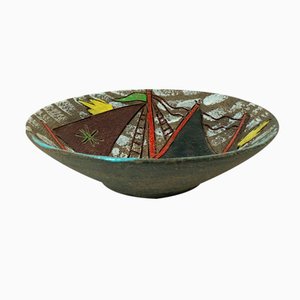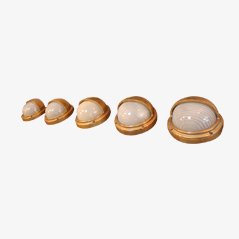Peter Sandmeyer recounts the glamorous heyday of Riva boats
La Dolce Vita on the Sea
-
The Superflorida
Courtesy of Riva
-
The Aquarama Special
Courtesy of Riva
-
The Aquarama Special
Courtesy of Riva
-
The Aquarama Special
Courtesy of Riva
-
The Aquarama Special
Courtesy of Riva
-
The Aquarama Special
Courtesy of Riva
-
The Aquarama Special
Courtesy of Riva
-
Anita Ekberg in her Ariston
Courtesy of Riva
-
The Ariston
Courtesy of Riva
-
The Ariston
Courtesy of Riva
-
The Ariston
Courtesy of Riva
-
The Ariston
Courtesy of Riva
-
The Corsaro
Courtesy of Riva
-
Courtesy of Riva
-
Peter Sellers and Britt Ekland, 1974
Courtesy of Riva
Riva. The nautical legend evokes images of la dolce vita under dazzling sunshine, pearly-white Mediterranean beaches, sapphire-blue waters, ice-cold rosé in frosted glasses, tiny bikinis, deep tans, and long hair in the wind. In the 1950s and '60s—the glamorous heyday of the Riva boat brand—these beauties were not merely a means of transportation; they were Ferraris on the water, incarnations of the lightness of a never-ending summer all along the Côte d’Azur and the lakes of Northern Italy.
Aristotle Onassis had one. Sophia Loren had one. Sean Connery, Richard Burton, Hugh Hefner, Brigitte Bardot, Roger Vadim, Anita Ekberg, Jean Paul Belmondo, Ferruccio Lamborghini, Gianni Agnelli, the Shah of Persia, the Aga Khan: The list of Riva owners reads like a Who’s Who of the era’s jetset crowd.
Gunter Sachs, the infamous playboy heir to the Opel fortune (and father of designer Rolf Sachs) had three. He first discovered Riva boats in the harbor of Monte Carlo and was taken on the spot. “I had owned other motorboats before and now recognized the difference between a peasant chair and a Louis XV chaise,” Sachs explained back in 2002. “What was floating there before me was the ultimate in Italian design, combined with the precision of Swiss clockwork and the dependability of U.S. elite engines. Immediately, I ordered a single-engine Ariston. Later, a twin-engine Aquarama, and then, a Super-Aquarama.”
The names of each Riva model were intended to capture their particular power, speed, and general desirability. Launched in 1953, Ariston—which in Greek means “the best”—is over six meters long with 185 horsepower. Aquarama—a concoction of “aqua” and “Cinerama”—entered the market in 1962. This line was a favorite of the world’s show business and finance moguls and features a panoramic windscreen reminiscent of a movie screen, a body close to nine meters long, 640 horsepower, and a maximum speed just shy of 90 km/h. Others included the Florida, the world of perpetual sunshine, and the Tritone, the son of Poseidon, god of the sea.
The origins of the Riva brand can be traced to Sarnico at Lake Iseo, in Lombardy, where the hardworking boatbuilder Pietro Riva settled in 1842 to repair fishing boats. His son, Ernesto, carried on the family business, running the small shipyard and building transport ships until he was tragically killed by one of his own creations at a ship christening in 1907. His brother, Serafino, took over and shifted the business focus to the production of the first flat speedboats powered by outboard engines, winning national and international races throughout the '20s and '30s and setting the first speed records: a proud 24km/h. Serafino was followed by his son and heir, Carlo Riva, born in 1922.
In the early '50s, Carlo realized the future no longer belonged to racing boats but to small, fast sport and leisure yachts—the kind of runabouts manufacturer Chris Craft was producing in the U.S. at the time. In 1951, he made a contract for the exclusive import of the day’s high performance boat engines—mighty, roaring eight-cylinder beasts—which he then fitted into his custom-tailored boats.
Carlo also transitioned the family business from bespoke to mass production, albeit under the ultimate craftsmanship. An exclusive wooden yacht series emerged, which used African mahogany for the frames and wooden profile parts for the hull (fabricated in their own molding press) and Honduran mahogany for the interior paneling. Eighteen coats of paint sealed the shell, allowing water to roll off like sparkling champagne. Light cherry or maple strips set off the rich, dark mahogany color. The posh upholstery was turquoise, cream, or vermilion, and the luster of opulent chrome on prow, cleats, board headlights, fans, and rims of the cockpit’s dashboard instruments shone brilliantly.
Carlo Riva was a perfectionist. Or more precisely, he was fastidious and feared stickler who fiddled with each detail, always wanting to improve everything and never accepting anything that did not meet his expectations. The mahogany he used had to be dried for three years in warehouses at room temperature. The motors, shafts, and screws were meticulously fine-tuned and optimized; the motors’ cooling systems, automated choke, and fuses were continually upgraded. Together with Edoardo Bianchi of Autobianchi, Carlo Riva developed a new type of chrome that was more resistant to saltwater. He sold no Riva without personally taking it out for a test ride, and so the story goes, he was always sneaking around the boats in the warehouses, screwdriver in hand, looking for paint defects. And when he found one, he ruthlessly scratched up the finish.
It is not known whether Prince Rainier III of Monaco was of similar disposition, but when he ordered a Riva boat in the mid 1950s and got to know its creator, the two men took a liking to each other. So much so that, in 1959, the prince permitted the boatbuilder to tunnel under the rock on which the Grimaldi Palace was located to establish the first storage and authorized workshop for Riva boats—thus solving the problem of the merciless Mediterranean sun drying out and cracking the boats’ paint. From then on, the wooden treasures rested in the damp twilight of the Monegasque cave. As necessary, they were hauled into the light with a beam hoist, delivered to their owners freshly serviced, washed, and tanked up. After the fairytale wedding of the Prince to Hollywood ingénue Grace Kelly, other movie stars and celebrities followed her to Monaco, turning the small princedom into a vital crossroad for the international jetset. In that milieu, a Riva on the water was as indispensible as a Rolex on the wrist.
Carlo Riva’s confident sense of style, attuned to the aspirations of the times, contributed to his success. He created pure leisure boats whose purpose was—as one could tell by the wide reclining areas—to have no purpose at all; they were fashioned to fill the leisure hours of their owners with the ultimate in cruising. With its cockpit instruments and steering wheel, its windscreen and wipers, its mighty horn, its cigarette lighter and ice box, he managed a kind of death-defying leap in design: after the big American cars had come with prows and tailfins inspired by ships, Carlo Riva now created boats that looked like luxury coupes.
In 1969, the company began to embrace the more “modern” medium of fiberglass and phased out the wooden designs that made Riva so famous. A year later, irked by continual strikes and conflicts, Carlo sold his business to American investors. Since May 2000, it has belonged to a subsidiary of the Italian boatbuilder, Norberto Feretti. The approximately 55 new ships per year now being built under the old name are enormous, luxury motor yachts. In total, some 2,000 of a total of 4,275 wooden Rivas survive today. These icons of a bygone era are exchanged among a growing body of avid collectors who appreciate the timelessness of a smooth ride, impeccable maneuvering, and luxurious functionality. In a word: perfection.
Translation by Suzanne R. Goff.
A version of this story first appeared in Berenberg Magazine No. 14; it has been edited and condensed for this edition.
-
Text by
-
Peter Sandmeyer
Adventurer and writer Peter was born and raised in Berlin, where he first learned to sail. In addition to his multiple books and articles, he has also journeyed across the Atlantic on Germany's fastest racing yacht, the Uca.
-
Designbegeisterte hier entlang
Italienische Mid-Century Steingutschale mit Sgrafitto Segelboot Motiv von Fratelli Fanciullacci

Brutalistische Hintergrundbeleuchtete Boot Wandskulptur aus Metall, 1960er

Mid-Century Palisander Esstisch oder Konferenztisch

Vintage Messing Bootslampen, 5er Set

















 The Riva Ariston in the 1960s
Courtesy of Riva
The Riva Ariston in the 1960s
Courtesy of Riva
